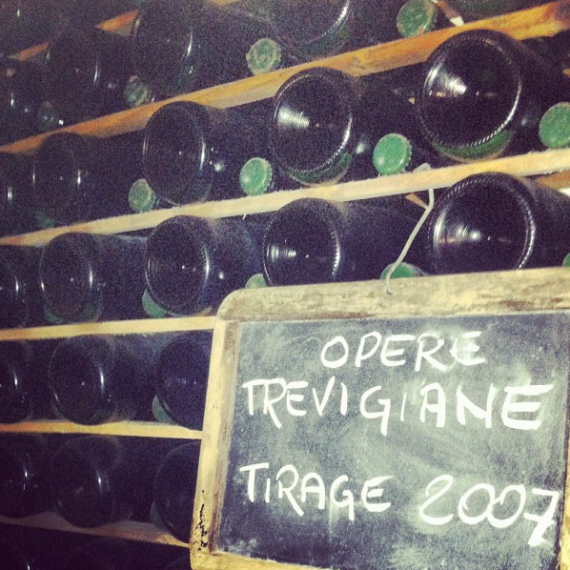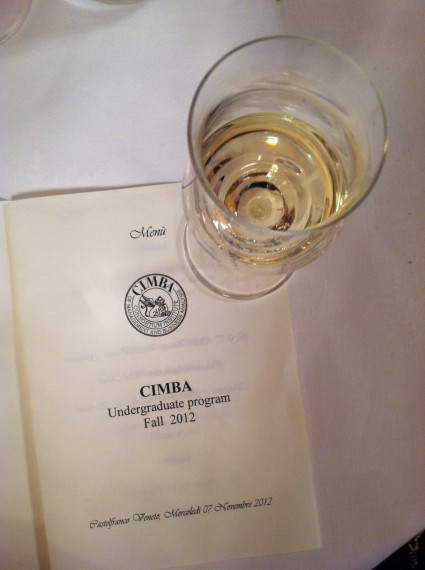
Vino Rosso o Vino Bianco?
Written by Morganne November 19, 2012
Wine is a big part of the Italian culture, as most people know, but I had no clue how in depth the wine world really is. Fortunately, I got to experience this firsthand with two activities I did this past week—a vineyard tour and a wine seminar.

Villa Sandi
Last Sunday a group of us visited local vineyard Villa Sandi. Unfortunately it was pouring outside so we didn’t get to see the actual vineyard itself, but we did get a tour of the wine cellars and a wine tasting. I was amazed at the vastness of the wine cellars. A huge underground maze of chamber after chamber, Villa Sandi must have had 10,000 bottles at least. Villa Sandi is known for its Prosecco, which is a dry, sparkling white wine produced in the Veneto region of Italy (where Venice and Paderno del Grappa are located). We got to taste theProsecco in addition to their Merlot and their Novella, a thinner red wine. A red girl myself, my favorite was the Merlot. Molto delizioso!
To build upon the Italian winery visit, last night Dr. Al, the head of CIMBA, gave a presentation on wine, detailing everything from how it’s made to the type of glass to use when drinking it. I actually learned a lot and want to share the most interesting things with you:
(1) Did you know you are supposed to hold a wine glass by the stem, not the glass part? This is a common mistake Americans make and is a dead giveaway for us amateurs visiting Europe. I had absolutely no idea, as my parents hold the glass and I’ve always thought it awkward to hold the stem. But the reason for that is to a) avoid making fingerprints on the glass and b) avoid changing the temperature of the wine. Who would’ve thought!
(2) Perhaps most people know this, but I had no clue the type of wines are named after their grape counterparts. Merlot, Pinot Noir, Chardonnay…all types of grapes! Also, there are white wines made from red grapes. The only difference is that they remove the skins. With rosé wine, which has a pinkish color to it, the red skins are removed at just the right point in time to allow a little color to seep through.
(3) The type of glass you should use to hold your wine is not based on whether it’s red or white, but rather the “bouquet” or the aroma of the wine. The more fragrance a wine has, the larger the glass opening should be. On the other hand, if the wine has a weaker aroma you should use a glass with a narrow opening to concentrate the smell as much as possible.
(4) The 4 S’s of professional wine tasting—See, Swirl, Smell, Sip. First you should look at the wine and make some observations about it, like the clarity of the color, etc. Second, swirl the wine in the glass which releases oxygen and betters the taste. Third, stick your nose in the glass and smell it. Fourth, sip the wine, taking care to get it in every nook and cranny of your mouth to really taste it. Pay attention to the after taste too!
(5) Like everything else about wine, there is a science to pairing foods with it. The pairing should be based on the quality of the food, such as its acidity or juiciness, matched to the complementary characteristics of the wine. This one is pretty in depth and a chart comes in handy. A basic guideline to remember, however, is white with fish and red with red meat.
(6) “Sell with cheese, buy on apple.” Did you know that cheeses mask the taste of a wine really well? If a wine has a sour after taste, eat it with a piece of cheese and the taste goes away. However, if you eat an apple it brings out the imperfections of the wine. So, the witty rule of thumb is to always have cheese on hand if you’re selling wine, and take an apple with you if you’re buying it.
Most importantly, how do you figure out what type of wine you like? Go to a restaurant, have everyone order from the same meat family, give your waiter a price range and he or she can usually help the group to find a wine to try. It’s all about practice, practice, practice and true mindfulness. You must really think about what you are tasting and experiment with all types of wine. Then you are well on your way to becoming a sommelier (a wine steward)!








